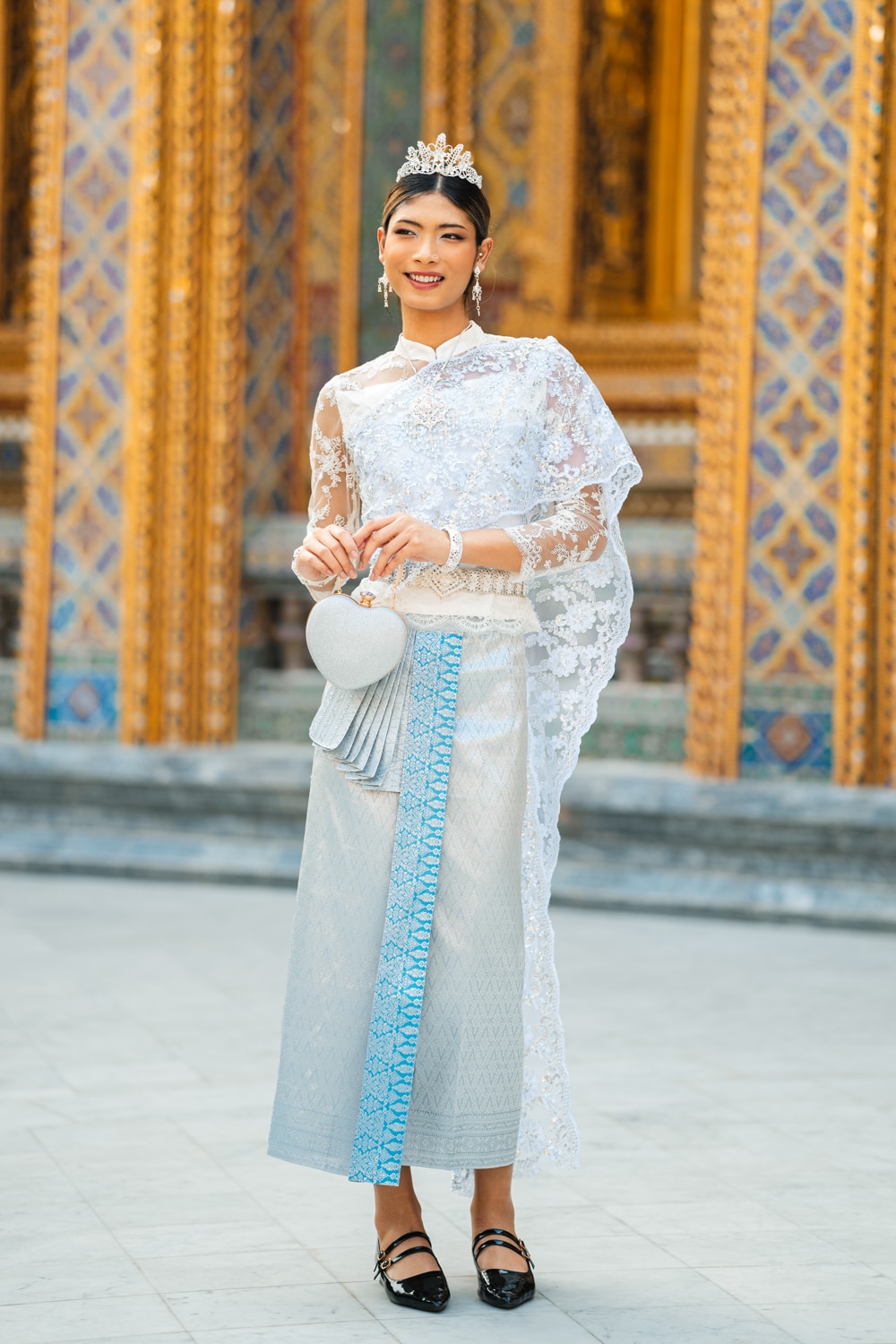The Rich Heritage of Thai Wedding Traditions
Thai weddings represent some of the most visually stunning ceremonies in Southeast Asian culture, with traditional attire playing a central role in these sacred unions. The ceremonial clothing, known collectively as “chut thai,” carries deep cultural significance that dates back centuries through Thailand’s rich history. These garments aren’t merely beautiful clothes but living artifacts that tell stories of Thailand’s royal heritage, Buddhist influences, and regional diversity. When couples choose traditional Thai wedding attire, they connect themselves to an unbroken lineage of cultural practices that have evolved yet maintained their essential character through countless generations. The vibrant colors, intricate embroidery, and meticulous craftsmanship seen in these wedding ensembles reflect Thailand’s artistic excellence and attention to detail. For visitors to Thailand seeking to understand Thai culture more deeply, witnessing or even participating in these traditions by renting a thai costume offers a profound window into the heart of Thai identity and values.
The Bride’s Traditional Ensemble
The bride’s traditional wedding attire, a specialized form of chut thai, transforms her into a vision of traditional Thai beauty. Typically, she wears a sabai—a silk shawl draped elegantly across one shoulder—paired with a long silk skirt called a pha sin. The sabai represents modesty and grace, while also showcasing the exquisite silk-weaving traditions that Thailand is famous for. Gold jewelry features prominently in the bride’s ensemble, with elaborate necklaces, bracelets, and headdresses that symbolize prosperity and status. These pieces often become cherished family heirlooms passed through generations. The color choices are equally significant, with gold and cream representing purity and prosperity, while other vibrant hues like red symbolize good fortune. Regional variations exist throughout Thailand, with northern styles featuring distinctive patterns and southern regions incorporating Malay influences. The process of dressing a Thai bride is itself ceremonial, often requiring assistance from experienced dressers who understand the precise way each element should be arranged. At SiamCrown, brides can experience the transformation of wearing these magnificent garments through their thai costume rental services, allowing them to honor these ancient traditions regardless of their background.
The Groom’s Traditional Attire
While the bride often receives the most attention, the groom’s traditional attire is equally significant in Thai wedding ceremonies. He typically wears a suea phraratchathan, a high-collared jacket inspired by royal court dress from the Rattanakosin era. This is paired with loose-fitting pants called chongkraben, which are wrapped and folded in a distinctive style that was once the formal dress code at the royal court. The ensemble often features rich silk fabrics in complementary colors to the bride’s outfit, creating a harmonious visual representation of their union. The groom may also wear a mongkol, a white cotton headband that symbolizes purity and is blessed by monks before the ceremony. His attire, like the bride’s, varies by region and family tradition, with some grooms opting for more elaborate royal-inspired ensembles complete with ceremonial swords and shoulder cloths. The dignity and formality of the groom’s chut thai reflects the seriousness with which Thai culture views marriage—as not merely a union between two people but between two families and their ancestors. For those seeking an authentic experience of Thai wedding traditions, proper attention to both the bride’s and groom’s attire is essential, and expert guidance in selecting appropriate thai costume rental options ensures respect for these time-honored practices.
The Sacred Bond: Symbolism in Thai Wedding Garments
Every element of traditional Thai wedding attire carries symbolic meaning that contributes to the ceremony’s spiritual significance. The layers of clothing represent the many layers of commitment in marriage, while the complementary designs of the bride and groom’s outfits symbolize harmony and balance. Gold, a prevalent material in Thai wedding jewelry, represents not just wealth but stability and endurance—qualities essential for a lasting marriage. Even the process of dressing involves ritual, with elders often helping the couple prepare while offering blessings and wisdom. The matching color schemes typically chosen for the wedding party create visual unity, reinforcing the communal nature of marriage in Thai culture. Buddhist influences appear throughout the attire, with certain patterns and motifs reflecting concepts like eternal love and spiritual protection. The craftsmanship required to create authentic chut thai for weddings preserves ancient techniques that might otherwise be lost in today’s mass-production era. Each stitch and embellishment represents countless hours of dedicated artisanship, making these garments true works of art. When couples choose traditional attire for their wedding, whether through thai costume rental or specially commissioned pieces, they’re not simply making a fashion statement but embracing a profound cultural legacy that honors ancestors and traditions while celebrating their unique love story.
Modern Adaptations of Traditional Wedding Attire
As Thailand embraces global influences, Thai wedding attire continues to evolve while maintaining its cultural essence. Contemporary couples often blend traditional elements with modern aesthetics, creating wedding ensembles that honor heritage while reflecting personal style. Designers now offer innovative interpretations of chut thai that feature updated silhouettes, contemporary fabrics, and creative color palettes that extend beyond traditional options. These adaptations make traditional attire more accessible and appealing to younger generations who might otherwise choose Western wedding styles. Many couples opt for traditional attire during ceremonial portions of their wedding before changing into modern formal wear for reception celebrations—a practice that beautifully bridges past and present. The rise of social media has also sparked renewed interest in traditional wedding attire, with stunning photographs of couples in elaborate chut thai inspiring others to explore these options. Despite these innovations, the fundamental elements and symbolism remain intact, ensuring that even modernized versions maintain cultural authenticity. For visitors to Thailand or those planning destination weddings in the country, services offering thai costume rental provide an opportunity to experience these evolving traditions firsthand. At SiamCrown, couples can explore both traditional and contemporary interpretations of wedding attire, allowing them to find the perfect balance between honoring tradition and expressing their unique style.
Regional Variations in Thai Wedding Costumes
Thailand’s diverse regions each contribute unique elements to traditional wedding attire, reflecting local history and cultural influences. In Northern Thailand, particularly around Chiang Mai and Lanna regions, wedding costumes feature distinctive patterns with Burmese influences, including embroidery techniques not commonly seen elsewhere. The northeastern Isaan region incorporates elements from Laotian culture, with silk patterns and accessories that tell stories of the Mekong River civilizations that have flourished there for centuries. Southern Thai wedding attire shows Malay peninsula influences through distinctive batik patterns and color choices that reflect the tropical environment and multicultural heritage of the region. Central Thai wedding costumes, often considered the standard for national Thai wedding attire, evolved from royal court dress and feature the most elaborate gold work and classic silhouettes. Even within these regional styles, family traditions create further variations, with heirloom pieces often incorporated into wedding ensembles to connect current celebrations to past generations. Understanding these regional differences adds depth to the appreciation of Thai wedding traditions and helps couples select attire that might reflect their family’s geographic origins within Thailand. For those seeking authentic regional styles, specialized thai costume rental services like those offered by SiamCrown provide access to these distinctive regional variations, allowing couples to celebrate Thailand’s diverse cultural heritage through their wedding attire.
Preparing for the Ceremony: Dressing Rituals and Traditions
The process of dressing for a Thai wedding involves its own set of meaningful rituals that extend beyond simply putting on beautiful clothes. The preparation typically begins early on the wedding day, often accompanied by traditional music and attended by close family members who assist with the complex garments. Specialized dressers, who understand the precise techniques required for proper arrangement of each element of the chut thai, are often hired to ensure everything is worn correctly according to tradition. Before dressing, many couples participate in a blessing ceremony where elders sprinkle scented water on their hands while offering good wishes for their marriage. The bride’s jewelry, particularly pieces passed down through generations, is presented with stories about family history and the women who wore these treasures before her. Throughout the dressing process, friends and family often share marriage advice and encouragement, turning this preparation time into an intimate bonding experience. Mirrors play an important role, with the first glimpse of the fully-dressed couple considered an auspicious moment. The entire dressing ritual can take several hours, emphasizing the importance of patience and careful attention to detail—qualities also essential in marriage. For those unfamiliar with these traditions but wishing to experience them, expert guidance through the dressing process is an essential part of any thai costume rental service, with establishments like SiamCrown providing not just the garments but the knowledge to wear them properly and respectfully.
Experiencing Thai Wedding Traditions as a Visitor
For travelers to Thailand, witnessing or participating in traditional wedding ceremonies offers a unique cultural immersion that goes beyond typical tourist experiences. Many visitors are surprised to discover that they can actually experience wearing traditional Thai wedding attire themselves through specialized thai costume rental services that cater to both locals and international guests. This opportunity allows foreigners to appreciate the weight, texture, and intricate details of authentic chut thai—something impossible to understand from photographs alone. When attending Thai weddings as guests, understanding the significance of the traditional costumes enhances appreciation for the ceremony’s beauty and meaning. Some couples planning destination weddings in Thailand incorporate elements of traditional Thai wedding attire into their celebrations as a way to honor the host country’s cultural heritage. Photography sessions in traditional Thai wedding costumes have become increasingly popular among tourists, creating lasting memories and stunning images that capture Thailand’s cultural richness. Local guides can provide valuable context about the symbolism and history behind specific elements of the wedding attire, transforming what might otherwise be simply a beautiful costume into a deeper cultural learning experience. For those interested in exploring this aspect of Thai culture during their travels, SiamCrown offers expert guidance and authentic thai costume rental options in Bangkok’s historic district, making these traditions accessible to curious visitors who approach them with respect and genuine interest in Thai heritage.
Preserving Heritage Through Traditional Craftsmanship
Behind every authentic piece of Thai wedding attire lies centuries of refined craftsmanship and artistic tradition that deserves recognition and preservation. The creation of a single traditional wedding ensemble may involve multiple specialized artisans, from silk weavers who produce the base fabrics to embroiderers who add intricate goldwork and jewelers who craft complementary accessories. These skilled craftspeople often learn their techniques through family apprenticeships, with knowledge passed down through generations using methods that remain largely unchanged for centuries. The economic pressures of modernization present challenges for these traditional crafts, as machine-made alternatives offer less expensive options that lack the cultural authenticity and quality of handcrafted pieces. Cultural heritage organizations throughout Thailand work to document traditional techniques and support master craftspeople through funding, education programs, and opportunities to showcase their work. When couples choose authentic traditional wedding attire, whether through purchase or thai costume rental, they actively participate in preserving these threatened cultural practices by creating demand for genuine craftsmanship. The subtle variations and “imperfections” found in handcrafted wedding garments tell stories of human touch that mass-produced items cannot replicate, giving these pieces soul and character beyond their visual beauty. Museums throughout Thailand display historic wedding attire to educate younger generations about their cultural heritage, but businesses like SiamCrown play an equally important role by keeping these traditions alive through practical application—allowing people to not just observe but experience the living heritage of chut thai in meaningful personal ceremonies.



